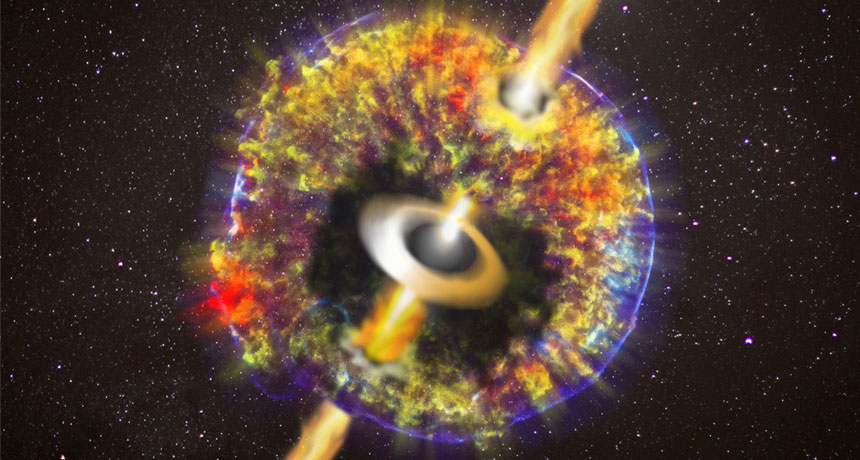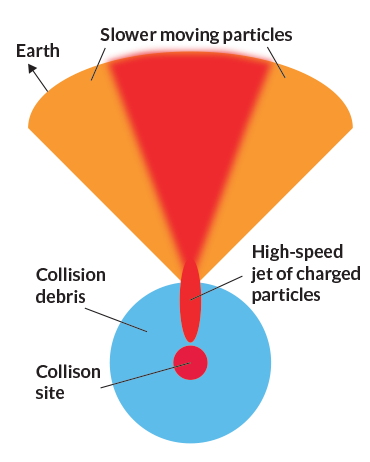
GREAT ESCAPE A bright jet of fast-moving particles fled the scene after two neutron stars collided, spewing material and potentially forming a black hole (shown in this artist’s illustration).
O.S. Salafia, G. Ghirlanda, CXC/NASA, GSFC, B. Williams et al
When a pair of ultradense cores of dead stars smashed into one another, the collision shot a bright jet of charged subatomic particles through space.
Astronomers thought no such jet had made it out of the wreckage of the neutron star crash, first detected in August 2017. But new observations of the crash site using a network of radio telescopes from around the world show that a high-speed stream of particles did escape from the debris, researchers report online February 21 in Science.
The work is part of an emerging consensus among scientists that the merger actually produced a jet, and could shed light on the origins of mysterious flashes of high-energy light called short gamma-ray bursts.
According to theory, a pair of crashing neutron stars should merge into another dense object, possibly a black hole. In the process, a combination of extreme energies and magnetic fields could launch a bright jet of electrons and protons moving close to the speed of light. Researchers think that such jets are seen from afar as short gamma-ray bursts, or GRBs. But no one has ever directly observed a neutron star collision producing the bursts.
The 2017 neutron star crash — the first time scientists had directly observed such a merger — provided the first chance to test the idea, says study coauthor and astrophysicist Giancarlo Ghirlanda of the National Institute for Astrophysics in Merate, Italy. That merger was picked up when the Advanced Laser Interferometer Gravitational-Wave Observatory, or LIGO, and its sister experiment, Advanced Virgo, detected ripples in spacetime called gravitational waves caused by the crash.
Previous gravitational wave detections involved colliding black holes, which did not emit any observable light. But the neutron star crash glowed in every wavelength of light astronomers checked, from long radio waves to short gamma rays (SN: 11/11/17, p. 6). Those extra observations let astronomers tease out details of the crash and its aftermath.
But, when scientists looked for jetlike gamma-ray emissions from the merger, they didn’t find any at first. Gamma rays were emitted after the crash, but they were much dimmer than expected from a GRB. And the light lingered longer than expected, continuing to glow in radio waves for more than 100 days after the collision.
Those observations led astrophysicist Kunal Mooley of Caltech and his colleagues to suggest that a jet did form, but was choked by a bubble of neutron-rich material kicked out of the neutron star crash (SN Online: 12/20/17). That bubble absorbed the jet’s energy, giving the bubble a long-lasting glow but smothering the jet itself.
In the new study, Ghirlanda and his colleagues report signs that the jet eventually burst free from the cocoon. The team observed the site of the crash with 32 radio telescopes around the world in mid-March 2018, about 207 days after the merger. The researchers combined signals from all the telescopes to act together as one single, gigantic telescope, letting the team zoom in on the scene.
A choked jet that lost all its energy to a neutron-rich bubble would appear as a relatively large sphere on the sky. But Ghirlanda and his colleagues saw a tiny, compact source of light, covering 1.5 milliarcseconds of sky — about the size of a nickel seen from 1,000 kilometers away. That light suggests that “a jet was launched, and it emerged successfully,” Ghirlanda says.
What’s more, unlike previously spotted short GRBs whose jets are aimed directly at Earth, the jet from the neutron star collision is moving toward Earth but 20 degrees off to the side, Ghirlanda’s team calculated.
“This is the first time in history that we have observed a jet which is not pointing toward the Earth,” says astrophysicist Om Sharan Salafia, also of the National Institute for Astrophysics. That means the jet has some observable structure, with faster moving particles in a central core and slower particles toward the edges — sort of like a fire hose surrounded by spray.
Two other recent studies have also suggested that the neutron star merger shot a jet through space. Mooley and colleagues used three different radio observatories to check in on the neutron star merger between 75 and 230 days after the crash. In September 2018, the researchers reported that they had observed a jet moving at the speed of light away from the crash site.
And the way that the merger’s light began quickly dimming 150 days after the collision also supports the idea that a jet burst into view and then faded, says astrophysicist Wen-fai Fong of Northwestern University in Evanston, Ill. If the dimming had been more gradual, it would have suggested that the jet was still trapped in the cocoon as it cooled off. Fong’s team reported observations of the merger up to 290 days after the crash in August 2018 in the Astrophysical Journal Letters, and has continued to observe the site since.
“It’s amazing that the astronomical community is using all of these different techniques to come to the same conclusion,” Fong says.
The fact that the first neutron star merger spotted produced a jet like the one expected from short GRBs is good news for GRB theories, Fong says. “If this neutron star merger didn’t produce a successful jet, we’d have to say, well, what are short GRBs?” she says. “We were a little bit worried that we’d have to explain short GRBs as a whole different phenomenon.”
To know how common jets are in neutron star clashes, astronomers will have to observe more of these collisions. And they might not have to wait long: The next LIGO and Virgo observing runs start in about five weeks. “We’re all very excited about what the future holds,” Fong says.
Editor’s note: This story was updated March 4, 2019, to correct the credit for the illustration of the neutron star collision.








